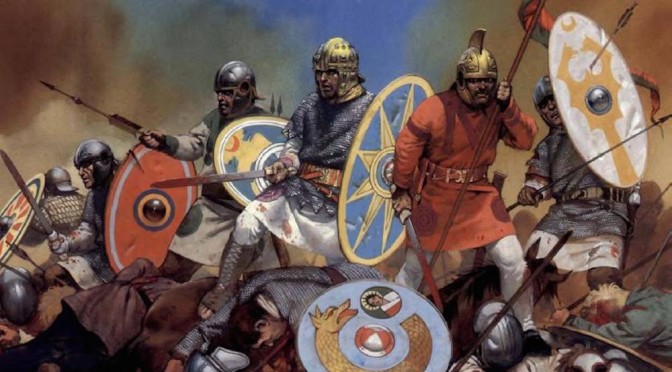The great conspiracy
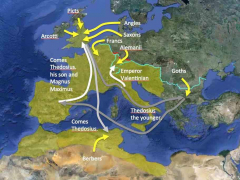 In 367 Constatius suggestion of aquistive invasion became a reality. Britain was invaded by Picts from the north, Arcotti ( Irish) from the West and Saxons from Germany.
In 367 Constatius suggestion of aquistive invasion became a reality. Britain was invaded by Picts from the north, Arcotti ( Irish) from the West and Saxons from Germany.The northern coast of Gaul was invaded by Saxons and Franks and the Rhineland by the Allemandii. The synchronisation made it obvious that the attacks were co-ordinated, but there is no record of who carried out the co-ordination.
In Britain, the situation was worsened by the fact that large numbers of legionares deserted and joined or even led bands of the invaders.
Nectarides, the Comes Littores Saxonici(Count of the Saxon Shore) who was responsible for the security on both sides of the english channel was killed.
These incursions are known as the “Great Conspiracy’.
Valantinian attacked the Alamanni and defeated them at Solicinium( modern Hechingen).
He sent Count Flavius Theodosius north. Count Theodosius was born in 325 in Cauca near Segovia in Spain. In 368 he was appointed by Valantinian as Comes Britanniarium charged with bringing order back to Britain. Thedosius was accompanied by his son, also named Thedosius and possibly by Magnus Maximus, known in British legends as Macsen Weldeg and is also said to have originated in Hispania. Magnus Maximus, according to some European genealogy, may have been Thedosius’ uncle.
Attack on the Theodosians
Order was restored to Britain and Magnus Maximus stayed there to ensure continuing stability.
In 372, there were problems in Africa. Roman settlements were being raided by “desert nomads”, who could have been Tuaregs or Berbers.
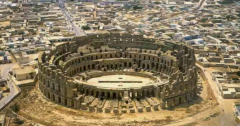 Roman resistance was inhibited by the machinations of Firmus, son of the client king Nubel and his children. Nubel was the most important client king but his children all sought all sought overall power. The Comes Africae, Romanus enriched himself by encouraging the competition, effectively selling the support of Rome to the highest bidder and only protecting cities who were prepared to pay him a bribe. Comes Theodosius was sent to resolve the situation and arrested Romanus and then defeated a revolt by Firmus. Unfortunately Valens, the Emperor of the east dissapproved. It did not end well. Theodosius the Elder was arrested and executed.
Roman resistance was inhibited by the machinations of Firmus, son of the client king Nubel and his children. Nubel was the most important client king but his children all sought all sought overall power. The Comes Africae, Romanus enriched himself by encouraging the competition, effectively selling the support of Rome to the highest bidder and only protecting cities who were prepared to pay him a bribe. Comes Theodosius was sent to resolve the situation and arrested Romanus and then defeated a revolt by Firmus. Unfortunately Valens, the Emperor of the east dissapproved. It did not end well. Theodosius the Elder was arrested and executed.
It is far from clear how Valens had the power to interfere as the area was definitely at that time part of the Western Empire.
In the meantime Thedosius the younger was sent to Moesia to take command of the Moesian legions. This area of operations was located in the eastern empire and subject to Valens. The younger Thedosius was accused of loosing two legions in the conflict with the Goths and accused of cowardice by deserting his legions when under attack.
He quickly retired to the family estates in Hispania where he was out of the reach of Valens. At some point in time Mediolanum (modern Milan) rather than Rome became the centre of the Western Roman Empire .
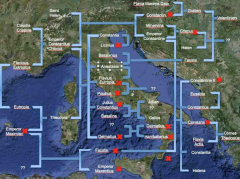
It is possible that the attack on the Thedosian family was because they were seen as a threat by Valens.
The sons of Valentinian
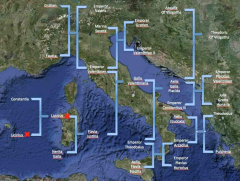
Valentinian was married to Marina Severa, who gave him a son Gratien. He then improved his own credibility as Emperor by marrying Flavia Justina a descendant of Constantina (the sister not the daughter of Constantine the Great). She also gave him a son Valentinian II. These two half brothers became a battleground for religius beliefs. The history of their lives is more about the conflict between the to main strands of christianity, Arianism and Trinitarianism, than about what they may or may not have done for the Empire. They both discriminated against those who worshipped the ancient gods, who they called pagans which in latin simply means civilian. The implication was that pagans were not part of the “Christian Army”
The instigator of the conflict was Ambrose, the bishop of Mediolanum. Ambrose was raised in Trier and therefore his early life had been influenced and disturbed by the various attempts to created an independant empire and the underlying adherance to the ancient religions.
Ambrose

Ambrose’s father, Aurelius Ambrosius had been the Pretorian Prefect of Gaul and was a Christian, probably a Trinitarian. Ambrose would have been brought up to believe that pagan worship was wrong (evil?). He was in Mediolanum because he was appointed by Valantinian as Pretorian prefect of the surrounding provinces of Liguria and Emilia.
In 374 the bishop of Mediolanum, Auxentus was an Arian, to whom Ambrose gave due respect. When Auxentus died however Ambrose made himself Bishop in his place and immediately banned the Arian faith, partly because Arians were tolerant of pagan beliefs.
In 375 Valantinian, a man know for his temper, was so enraged by what he saw as the unreasonable attitude of the Quadi, a Germanic tribe who had invaded Roman territory, that he suffered a stroke and died.
This made Gratien, at sixteen, emperor of the west, his capital was Mediolanum and he was by now under the influence of Ambrose.
The army voted Valentinian II, Gratien’s half brother as Emperor. At the time Valentinian II was only four years old and very much under the influence of his mother Justina. Justina distinguished herself by being strongly commited to the Arian, not the Trinitarian faith.
Gratian accepted the Army’s decision and split the western empire in two. He became Emperor of the Celtic lands (Gaul, Hispania and Britain) and Valentinian II, with his mother as regent became Emperor of Italy, Illyricum and Africa. Both Gratien and Valantinian maintained their capital in Mediolanum where Justina soon found herself found herself in opposition to Ambrose. This sub division resurrected the problem that the lands governed by Gratian had no access to African grain.
Though a young man Gratien distinguished himself in a war against the Alamanni at the battle of Argentovaria.
 He then marched east to provide assistance to Valens who was still Emperor. It was Valens who first introduced Goths into the empire. He intended that there should be a controlled immigration but it got out of hand. The lands south of the Danube were overwhelmed. The existing residents protested and conflict was inevitable. In 378 the two sides met at Adrianople. Valens attacked the Goths without waiting for Gratien to arrive. It was a disaster. Valens himself and his senior commanders were killed along with two thirds of his army.
He then marched east to provide assistance to Valens who was still Emperor. It was Valens who first introduced Goths into the empire. He intended that there should be a controlled immigration but it got out of hand. The lands south of the Danube were overwhelmed. The existing residents protested and conflict was inevitable. In 378 the two sides met at Adrianople. Valens attacked the Goths without waiting for Gratien to arrive. It was a disaster. Valens himself and his senior commanders were killed along with two thirds of his army.Gratian believed he could not recoup the situation alone. What he did is, relying only on mainstream history, without rational explanation,. He recalled the younger Thedosius from Hispania and in 379 raised him to be Emperor of the East.
Theodosius had retired to the west, possibly to be out of Valens’ reach. Now Valens was dead he felt safe to emerge, but for it to happen so quickly he must have kept touch with someone and even then what set him apart as a candidate for Emporer? One version of the genealogy explains a possible scenario whereas Valentine and Valens were descended from Constantius Chorus, explaining their elevation to the purple, but that the Thedosians were descended from Constantine himself and did indeed have better claim.
Theodosius
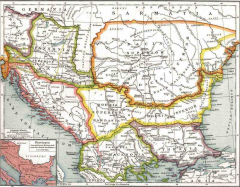
The Emporer Thedosius is know to history as “the great” one of very few people to earn that title. What was it which sets him alongside Xerxes, Darius, Alexander, Herod, Pompey, sand Constantine?
The unescapable answer is that it was Thedosius, not Constantine who declared Trinitarian Christianity be be the state religion and most historians regard that as a great achievement.
He had two priorities. He spent the first twelve months making a settlement with the Goths, which resulted in them settling within the empire more peaceably. The benefit of hindsight shows that the Gothic issued was never resolved satisfactorily.
He then turned his attention to religion. One of Thedosius targets was to change christianity from the Arian to the Trinitartian(Nicene) belief, but in fact most Goths were Arian christians. Therefore his attempts to solve a problem in one area were thwarted by his initiative in the other area.
The edict of Thessalonica
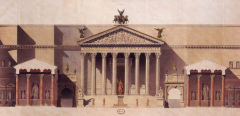 In 380 Thedosius was baptised, by Ambrose, as a Nicene christian and published The “Edict of Thessalonica” which dictated that all Romans should follow “the fath of the bishops of Rome and Alexandria”. Later in the year when he first arrived in Constantinople his first act was to depose the bishop of Constantinople and replace him with a nicene appointee.
In 380 Thedosius was baptised, by Ambrose, as a Nicene christian and published The “Edict of Thessalonica” which dictated that all Romans should follow “the fath of the bishops of Rome and Alexandria”. Later in the year when he first arrived in Constantinople his first act was to depose the bishop of Constantinople and replace him with a nicene appointee.The following year (381)at the church council of Constantinople the necessary christian beliefs were defined and for the first time the Bishop of Rome was declared to be superior to the Bishop of Constantinople.
Thedosius then started his move against pagans. He made it a crime for magistrates to fail to fail to enforce anti-pagan laws and established a programme for the destruction of pagan temples including the temple of mars in the forum. He banned all non christian feast-days, disbanded the vestal virgins and banned the olympic games.
The edicts were counter signed by Gratien. In the West the senate appealed to Gratien as Pontifex Maximus, chief priest of the roman state, to maintain the ancient rites of the Roman state. He ignored their pleas and resigned from the position of Pontifex Maximus.
Macsen Weldig
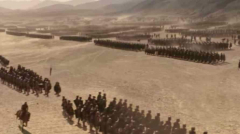
In 383 there was again a revolt originatating in Britain. Magnus Maximus, known in British history as Macsen Weldig invaded Gaul and Gratien was killed in battle. Maximus was well recieved by the senate as he was sympathetic to the cause of the pagans.
Maximus was accepted as the emperor of Britain, Gaul and Hispania but probably at the request of the senate invaded Italy in 387. Bishop Ambrose negotiated with Maximus and gave time for Valantinian II to flee to the east. Valantinian returned, supported by Thedosius and a predominently gothic army to defeat Maximus.
Maximus seems to have been defeated at the battle of the Save river(probably Sisak ,Croatia) by the use of mounted archers fighting in the style of the Thracians
Once again there were great losses and it must be assumed that a large proportion of those killed would have been from the gallic legions. The majority of Britain’s armed forces left to support Maximus and never returned.
Arbogast
Thedosius appointed Arbogast as magister militum of the west and as his first assignment ordered him to murder Maximus’ son Flavius Victor.
Whilst Maximus was fighting against Thedosius and Valantinian Britain and Northern Gaul were left undefended. The Franks invaded Gaul and the Saxons England.
In 392 Valentinian II, just twenty one, was murdered. Valantinian had adhered to the Arian faith. In a series of attacks by Trinitarians his mother Justina was accused of being a Lesbian and Valantinian of being illigitimate ( or the product of a polygamous marriage). The attacks were clearly designed to undermine Valentinian’s position.
Arbogast then promoted Eugenius as Emperor. Possibly to gain support or possibly to counter the persecution of pagans. Eugenius allowed the rebuilding of pagan temples including the reinstallation of the Altar of Victory in the Roman Forum. Mainstream history has Eugenius as an academic, selected by Arbogast simply because he had a Roman pedigree but british records suggest he was another son of Macsen Weldeg. It is problematic as between the murder of Flavius Victor and the support for Eugenius, Arbogast must have had a complete change of heart.
Eugenius replaced the Constantine symbol of chi rho on his standards with images of Hercules and carried statues of other roman gods with him as he marched to meet Theodosius. Thus once again the battle which eventuated at the river Frigidus was not just about who ruled Rome but about wether continued support for the ancient gods would be allowed. Theodosius and Christianity won and the destruction of pagan temples recommenced.
Stilicho
In Thedosius army was Flavius Stilicho, Magister Militum of the East, soon to be appointed Magister Militum of the west. He replaced Arbogast, who committed suicide. Also fighting for Thedosius that day, were the goths under Alaric. Contantius’tactic from fifty years earlier was now reality; Christian tribes from outside invading a stubbornly Pagan Western Empire.
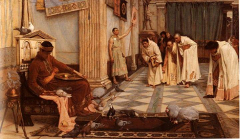 Thedosius died in 395. He had appointed his sons Arcadius and Honorius as emporers of respectively East and West. Arcadius was eighteen, Honorius was eleven. As well as his apointment as Magister Militum Stilicho was appointed caretaker for Honorius until he came of age.
Thedosius died in 395. He had appointed his sons Arcadius and Honorius as emporers of respectively East and West. Arcadius was eighteen, Honorius was eleven. As well as his apointment as Magister Militum Stilicho was appointed caretaker for Honorius until he came of age.Despite fighting for Theodosius at the battle of Frigidus, Alaric soon rebelled against Arcadius. The roots of the conflict was most probably religious discrimination, as the Goths were staunchly Arian, coupled with a management policy which amounted to starvation of his people.
The situation quickly escalated. In 397 Stichlo went east to fight against the uprising and had the Gothic army trapped and surrounded on two separate occasions but mysteriously allowing them to escape. Historians explain this by saying that on both occasions Arcadius ordered Stilicho to leave the eastern empire.
Stilicho then went to Africa to deal with a continuation of the in fighting amongst the client kings which had brought about the downfall of Thedosius the elder.
Soon afterwards in 1398 Stilicho went to (invaded?) Britain which was descending into a civil war amongst the various tribes and in which Wales, Cornwall, and Strathclyde had made themselves independent. British records say this independence was achieved under the leadership of Helen of the Hosts, Macsen’s widow.
Constantine III
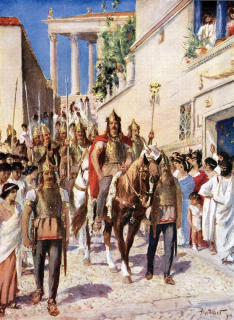 During Stilicho’s absence Alaric moved into Italy. Milan, with Honarius inside the city walls, was put under siege. Stilicho arrived just in time to save Honorarius and by negotiation persuaded Alaric to withdraw to Illiricum.
During Stilicho’s absence Alaric moved into Italy. Milan, with Honarius inside the city walls, was put under siege. Stilicho arrived just in time to save Honorarius and by negotiation persuaded Alaric to withdraw to Illiricum.
In 495, a mass of Vandals, Burgundians, Alans and Sueves invaded Italy. Stichilo managed to force them to withdraw but made no attempt to prevent the same peoples crossing the Rhine in huge numbers on December 31 496, the year of the Migrations.
There were two results of this: firstly yet another revolt arose in Britain under the leadership of Flavius Claudius Constantius, known in Britain as Constantine III, secondly both Stichilo and his son Eucherius were executed.
Constantine III attempted to restore order to Gaul, taking with him the last vestiges of Roman troops but now supplemented by british war lords, once again leaving Britain poorly defended.
Despite the lawless conditions in Gaul, in his last days in power Stilicho sent an army against Constantine III when he could easily have co-operated with him to control the invaders.
Constantine defeated Stilicho’s army and then managed to shepherd the invaders south towards Hispania. Hoping to trap them against the Pyrenees. He sent his son ahead to capture the Theodosian estates and to defend the Pyrenean passes.
It was the renewed Saxon attacks on Britain which caused Constantines’ downfall. Under pressure to return to defend Britain he attempted to invade Italy to bring a speedy resolution. He failed and eventually was trapped and besieged at Arles.
He was executed but was instantly replaced by Jovinus. At this point the Pyrenean passes were still controlled by Constantine’s soldiers.
Stichilo, at the time of his death was attemting to mobilise a gothic army, not to deal with the Germanic tribes causing havoc in Gaul but to forcably remove Illyrium from the empire of the East and place it under the control of the Western empire. Why such a task should be given priorty is unknown. The wives and children of the gothic soldiers he had recruited for this task were in camps in Italy and when he was executed they were murdered on the orders of Olympus, a relatively minor administrator.
The March of the Goths
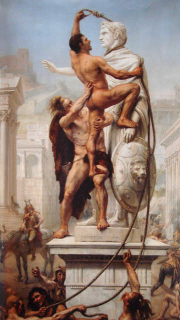 The result was a renewed invasion of Italy by the Visigoths and Rome was besieged from 408 to 410 when the gates were opened and the city plundered.
The result was a renewed invasion of Italy by the Visigoths and Rome was besieged from 408 to 410 when the gates were opened and the city plundered.
It is obvious that the Visigoths were bought off with a promise they would be allowed to take over South West Gaul. Their first initiative having left Rome was to destroy Jovinus’ army and remove Constantine’s men from the pyrenean passes. The Vandals, Alans and Sueves were chased into Hispania where they were then defeated by the Visigoths at a later date.
There would be another chaotic 60 years before the last of the Western Emperors were deposed but the rule of the Western Empire effectively ended with this event.
Too little too late
Under the rule of Justinian in 531 the Empire in the East made massive efforts to retake the western empire but it was a classic case of too little too late, by the time it was attempted the citizens of the empire no longer saw themselves as Romans and saw Justinians’ efforts as Byzantine aggression.
